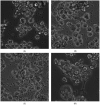Evaluation of the Safety and Toxicity of the Original Copper Nanocomposite Based on Poly-N-vinylimidazole
- PMID: 35009966
- PMCID: PMC8746882
- DOI: 10.3390/nano12010016
Evaluation of the Safety and Toxicity of the Original Copper Nanocomposite Based on Poly-N-vinylimidazole
Abstract
A new original copper nanocomposite based on poly-N-vinylimidazole was synthesized and characterized by a complex of modern physicochemical and biological methods. The low cytotoxicity of the copper nanocomposite in relation to the cultured hepatocyte cells was found. The possibility to involve the copper from the nanocomposite in the functioning of the copper-dependent enzyme systems was evaluated during the incubation of the hepatocyte culture with this nanocomposite introduced to the nutrient medium. The synthesized new water-soluble copper-containing nanocomposite is promising for biotechnological and biomedical research as a new non-toxic hydrophilic preparation that is allowed to regulate the work of key enzymes involved in energy metabolism and antioxidant protection as well as potentially serving as an additional source of copper.
Keywords: copper nanocomposite; copper-dependent enzyme systems; cytotoxicity; hepatocyte; poly-N-vinylimidazole.
Conflict of interest statement
The authors declare no conflict of interest.
Figures















Similar articles
-
Green Synthesis of Stable Nanocomposites Containing Copper Nanoparticles Incorporated in Poly-N-vinylimidazole.Polymers (Basel). 2021 Sep 22;13(19):3212. doi: 10.3390/polym13193212. Polymers (Basel). 2021. PMID: 34641028 Free PMC article.
-
A facile fabrication of silver/copper oxide nanocomposite: An innovative entry in photocatalytic and biomedical materials.Photodiagnosis Photodyn Ther. 2020 Sep;31:101814. doi: 10.1016/j.pdpdt.2020.101814. Epub 2020 May 11. Photodiagnosis Photodyn Ther. 2020. PMID: 32437975
-
Copper-polyaniline nanocomposite: Role of physicochemical properties on the antimicrobial activity and genotoxicity evaluation.Mater Sci Eng C Mater Biol Appl. 2018 Dec 1;93:49-60. doi: 10.1016/j.msec.2018.07.067. Epub 2018 Jul 24. Mater Sci Eng C Mater Biol Appl. 2018. PMID: 30274082
-
Preclinical functional characterization methods of nanocomposite hydrogels containing silver nanoparticles for biomedical applications.Appl Microbiol Biotechnol. 2020 Jun;104(11):4643-4658. doi: 10.1007/s00253-020-10521-2. Epub 2020 Apr 6. Appl Microbiol Biotechnol. 2020. PMID: 32253473 Review.
-
New hepatocyte in vitro systems for drug metabolism: metabolic capacity and recommendations for application in basic research and drug development, standard operation procedures.Drug Metab Rev. 2003 May-Aug;35(2-3):145-213. doi: 10.1081/dmr-120023684. Drug Metab Rev. 2003. PMID: 12959414 Review.
Cited by
-
Water-Soluble Nanocomposites Containing Co3O4 Nanoparticles Incorporated in Poly-1-vinyl-1,2,4-triazole.Polymers (Basel). 2023 Jul 4;15(13):2940. doi: 10.3390/polym15132940. Polymers (Basel). 2023. PMID: 37447585 Free PMC article.
References
-
- Saporito-Magriñá C.M., Musacco-Sebio R.N., Andrieux G., Kook L., Orrego M.T., Tuttolomondo M.V., Desimone M.F., Boerries M., Borner C., Repetto M.G. Copper-induced cell death and the protective role of glutathione: The implication of impaired protein folding rather than oxidative stress. Metallomics. 2018;10:1743–1754. doi: 10.1039/C8MT00182K. - DOI - PubMed
LinkOut - more resources
Full Text Sources

